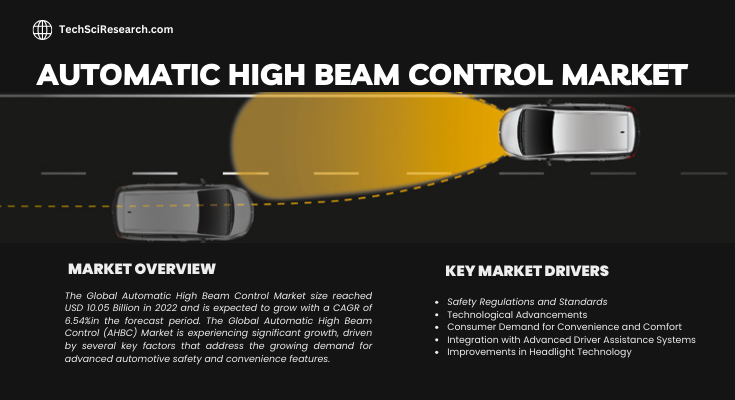According to TechSci Research report, “Automotive High Beam Control Market – Global Industry Size, Share, Trends, Competition Forecast & Opportunities, 2028”, the Global Automotive High Beam Control Market stood at USD 10.05 Billion in 2022 and is anticipated to grow with a CAGR of 6.54% in the forecast period, 2024-2028. The Global Automatic High Beam Control Market is experiencing substantial growth, driven by various trends and factors that cater to the increasing demand for advanced automotive safety features.
The primary driver behind the growth of the Automatic High Beam Control (AHBC) market is the increasing focus on road safety. Governments and regulatory bodies worldwide are emphasizing the integration of advanced safety features in vehicles to reduce accidents and enhance overall road safety. Automotive high beam control systems contribute to this objective by automatically adjusting the vehicle’s headlights based on surrounding conditions, optimizing visibility without causing glare to oncoming drivers.
The automotive industry is witnessing rapid technological advancements, and automotive high beam control is no exception. Continuous improvements in sensor technologies, including cameras and light detection and ranging (LiDAR) systems, have enhanced the accuracy and efficiency of automatic high beam control systems. These technological innovations make automotive high beam control more reliable and attractive to consumers, driving market growth. automotive high beam control is often integrated into broader Advanced Driver Assistance Systems, which are gaining widespread acceptance. The synergy between automotive high beam control and other ADAS components, such as adaptive cruise control and lane departure warning systems, provides a comprehensive safety solution. Consumers are increasingly seeking vehicles equipped with these integrated safety features, contributing to the growth of the automotive high beam control market.
Growing awareness among consumers regarding the benefits of automatic high beam control is a significant trend. As consumers become more informed about safety technologies, there is a higher demand for vehicles equipped with features that enhance driving comfort and safety. automotive high beam control’s ability to improve visibility during night driving without causing inconvenience to other road users aligns with consumer preferences for advanced safety features.
Governments and regulatory authorities are playing a pivotal role in driving the adoption of automotive high beam control. Many countries are incorporating safety standards that encourage or mandate the inclusion of advanced safety features in vehicles. This regulatory support acts as a catalyst for the growth of the automotive high beam control market, as automakers strive to comply with these standards and differentiate their products in the market. The overall growth of the automotive industry is a fundamental factor contributing to the expansion of the automotive high beam control market. As the number of vehicles on the road increases, there is a parallel rise in the demand for safety features, including automotive high beam control, creating a favorable environment for market growth.
Browse over market data Figures spread through 180 Pages and an in-depth TOC on “ Global Automotive High Beam Control Market.” @ https://www.techsciresearch.com/report/automatic-high-beam-control-market/20770.html
In North America, the automotive high beam control market is witnessing steady growth, primarily driven by the region’s stringent safety regulations and the increasing emphasis on advanced driver assistance systems (ADAS). Consumers in North America prioritize safety features, and automakers are responding by integrating automotive high beam control into their vehicles to enhance overall safety performance.
Europe & CIS has been at the forefront of automotive safety innovations, and the automotive high beam control market is no exception. The European & CIS market is characterized by a high level of awareness among consumers regarding road safety, prompting the adoption of advanced safety technologies. Regulatory bodies, such as the European New Car Assessment Programme (Euro NCAP), also play a crucial role in promoting automotive high beam control adoption by incorporating safety ratings that consider the presence of such features.
The Asia-Pacific region is emerging as a key growth market for automotive high beam control, driven by the rapid expansion of the automotive industry and the increasing purchasing power of consumers. Growing urbanization and the subsequent rise in traffic congestion have heightened the demand for safety technologies, making automotive high beam control an attractive feature for consumers in countries like China, Japan, and South Korea.
In South America, the adoption of automotive high beam control is influenced by a combination of economic factors and changing consumer preferences. While the market is still developing, the awareness of safety technologies is growing, and automakers are gradually incorporating automotive high beam control to cater to safety-conscious consumers.
The automotive high beam control market in the Middle East and Africa is experiencing gradual growth, driven by a mix of economic development and increasing awareness of advanced automotive technologies. As disposable incomes rise and urbanization progresses, consumers in this region are showing a growing interest in vehicles equipped with safety features like automotive high beam control.
Major companies operating in the Global Automotive High Beam Control Market are:
- H ELLA GmbH & Co. KGaA,
- Marelli Holdings Co., Ltd.
- Valeo
- Continental AG
- Koninklijke Philips N.V.
- Robert Bosch GmbH
- HYUNDAI MOBIS.
- Renesas Electronics Corporation
- Aptiv.
- Stanley Electric Co., Ltd.
- DENSO CORPORATION
Download Free Sample Report @ https://www.techsciresearch.com/sample-report.aspx?cid=20770
Customers can also request 10% free customization in this report.
“Across regions, there is a common trend of automotive high beam control being integrated into broader ADAS packages. The seamless integration of automotive high beam control with other safety features, such as adaptive cruise control and lane-keeping assist, is becoming a global standard. Additionally, the ongoing advancements in sensor technologies and the development of connected and autonomous vehicles are expected to further shape the future of the global automotive high beam control market.,” said Mr. Karan Chichi, Research Director with TechSci Research, a research-based management consulting firm.
“Automatic High Beam Control Market – Global Industry Size, Share, Trends Opportunity, and Forecast, Segmented By Vehicle Type (Passenger Cars, Commercial Vehicles), By Propulsion Type (ICE, Electric), By Sales Channel (OEM, Aftermarket), By Technology (Laser Sensor, Ultrasonic Sensor, Radar Sensor), By Region, Competition, 2018-2028”, has evaluated the future growth potential of Global Automotive High Beam Control Market and provides statistics & information on market size, structure, and future market growth. The report intends to provide cutting-edge market intelligence and help decision makers take sound investment decisions. Besides, the report also identifies and analyzes the emerging trends along with essential drivers, challenges, and opportunities in the Global Automotive High Beam Control Market.
You may also read:
Crossover Vehicles Market Detailed Analysis of Share, Growth [2028]
Automobile Muffler Market on the Rise [2028]- A Deep Dive into the Growth & Forecast
Auxiliary Oil Cooler Market Trends [2028]- Exploring the Dynamics of Industry
Automotive Brake Valve Market is Set for Robust Growth during the forecast [2028]
Car Wash Detergents Soaps Market [2028] Analysis, Trends, and Key Players.
Table of Content-Automatic High Beam Control Market
- Introduction
1.1. Product Overview
1.2. Key Highlights of the Report
1.3. Market Coverage
1.4. Market Segments Covered
1.5. Research Tenure Considered
- Research Methodology
2.1. Objective of the Study
2.2. Baseline Methodology
2.3. Key Industry Partners
2.4. Major Association and Secondary Sources
2.5. Forecasting Methodology
2.6. Data Triangulation & Validation
2.7. Assumptions and Limitations
- Executive Summary
3.1. Market Overview
3.2. Market Forecast
3.3. Key Regions
3.4. Key Segments
- Impact of COVID-19 on Global Automatic High Beam Control Market
- Global Automatic High Beam Control Market Outlook
5.1. Market Size & Forecast
5.1.1. By Value & Volume
5.2. Market Share & Forecast
5.2.1. By Vehicle Type Market Share Analysis (Passenger Cars and Commercial Vehicles)
5.2.2. By Propulsion Type Market Share Analysis (ICE and Electric)
5.2.3. By Sales Channel Market Share Analysis (OEM, Aftermarket)
5.2.4. By Technology Market Share Analysis (Laser Sensor, Ultrasonic Sensor, Radar Sensor)
5.2.5. By Region Market Share Analysis
5.2.5.1. Asia-Pacific Market Share Analysis
5.2.5.2. Europe & CIS Market Share Analysis
5.2.5.3. North America Market Share Analysis
5.2.5.4. South America Market Share Analysis
5.2.5.5. Middle East & Africa Market Share Analysis
5.2.6. By Company Market Share Analysis (Top 5 Companies, Others – By Value, 2022)
5.3. Global Automatic High Beam Control Market Mapping & Opportunity Assessment
5.3.1. By Vehicle Type Market Mapping & Opportunity Assessment
5.3.2. By Propulsion Type Market Mapping & Opportunity Assessment
5.3.3. By Sales Channel Market Mapping & Opportunity Assessment
5.3.4. By Technology Market Mapping & Opportunity Assessment
5.3.5. By Regional Market Mapping & Opportunity Assessment
- Asia-Pacific Automatic High Beam Control Market Outlook
6.1. Market Size & Forecast
6.1.1. By Value & Volume
6.2. Market Share & Forecast
6.2.1. By Vehicle Type Market Share Analysis
6.2.2. By Propulsion Type Market Share Analysis
6.2.3. By Sales Channel Market Share Analysis
6.2.4. By Technology Market Share Analysis
6.2.5. By Country Market Share Analysis
6.2.5.1. China Market Share Analysis
6.2.5.2. India Market Share Analysis
6.2.5.3. Japan Market Share Analysis
6.2.5.4. Indonesia Market Share Analysis
6.2.5.5. Thailand Market Share Analysis
6.2.5.6. South Korea Market Share Analysis
6.2.5.7. Australia Market Share Analysis
6.2.5.8. Rest of Asia-Pacific Market Share Analysis



